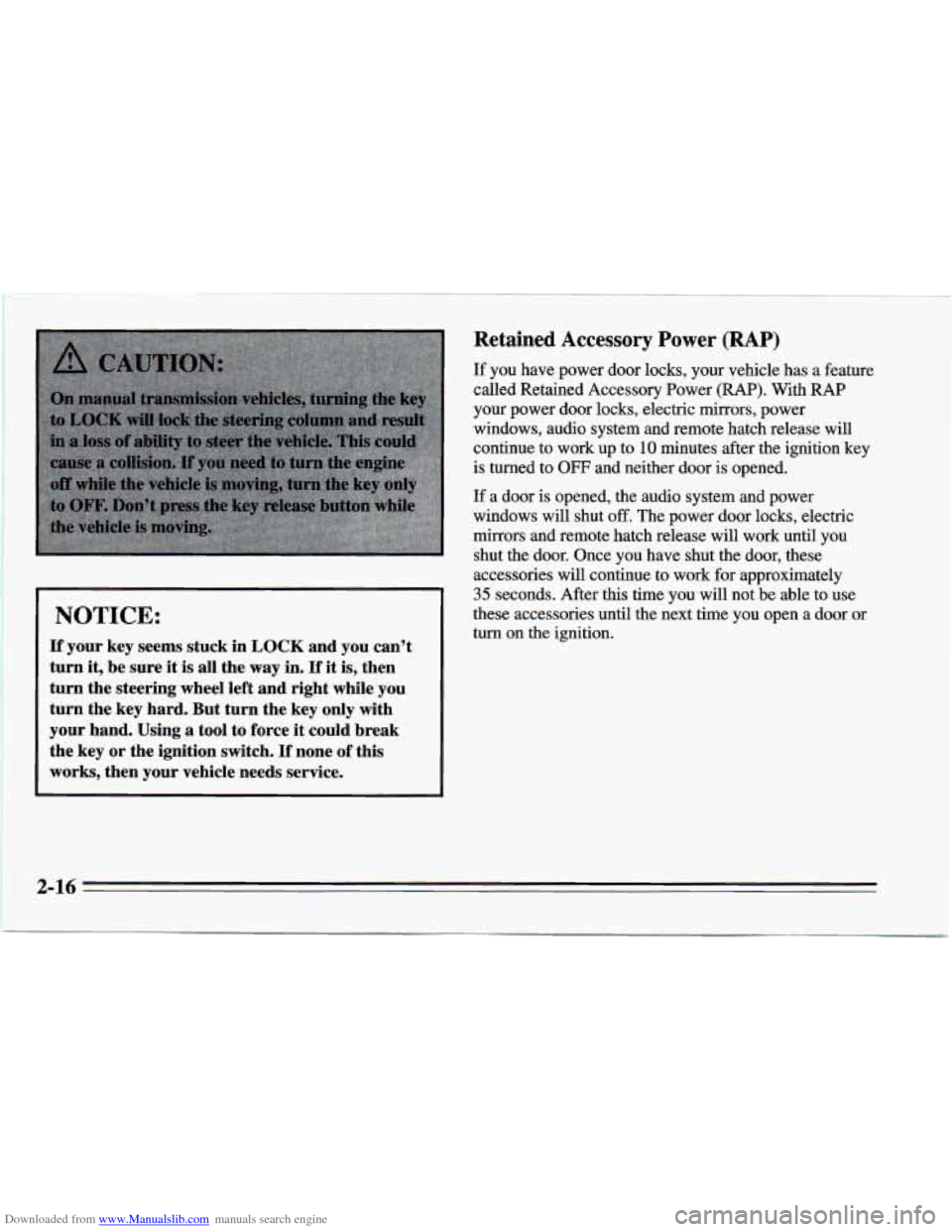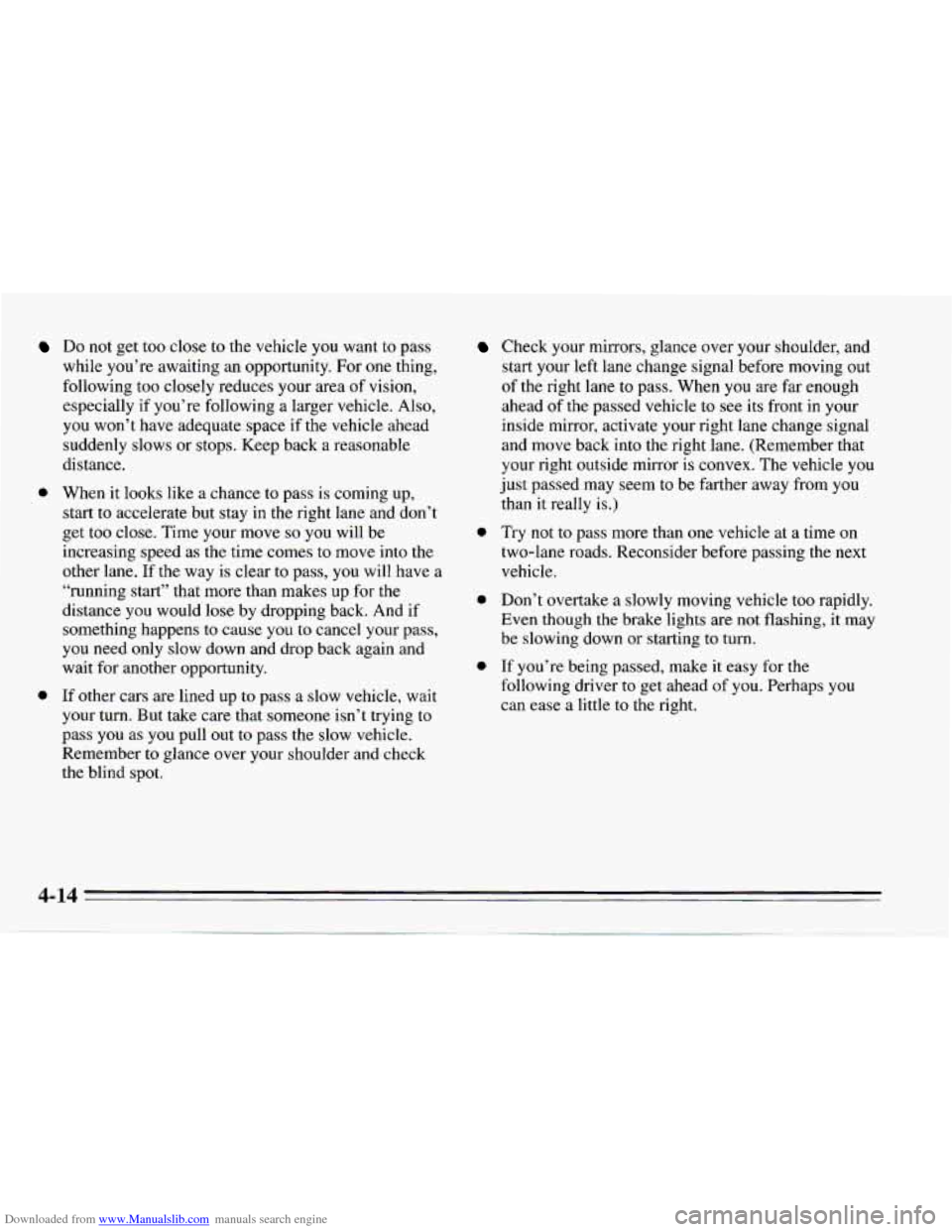Page 68 of 388

Downloaded from www.Manualslib.com manuals search engine Retained Accessory Power (RAP)
NOTICE:
If your key seems stuck in LOCK and you can’t
turn
it, be sure it is all the way in. If it is, then
turn the steering wheel left and right while you
turn the key hard. But turn the key
only with
your hand. Using a tool to force
it could break
the key or the ignition switch.
If none of this
works, then your vehicle needs service. If you have
power door locks, your vehicle has a feature
called Retained Accessory Power (RAP). With RAP
your power door locks, electric mirrors, power
windows, audio system and remote hatch release will
continue to work up to
10 minutes after the ignition key
is turned to
OFF and neither door is opened.
If a door is opened, the audio system and power
windows will shut
off. The power door locks, electric
mirrors and remote hatch release will work until you
shut the door. Once you have shut the door, these
accessories will continue to work for approximately
35 seconds. After this time you will not be able to use
these accessories until the next time you open a door or
turn on the ignition.
2-16
Page 102 of 388
Downloaded from www.Manualslib.com manuals search engine Front Map Lamps
Your inside rearview mirror includes two map lamps.
Each lamp has its own switch. Use the switch closest to
the lamp to turn it on. The lamps will also
go on when a
door is opened.
Courtesy lamps include the dome lamp and other lamps
throughout the interior
of your vehicle.
Mirrors
Inside Daymight Rearview Mirror
An inside rearview mirror is attached to your
windshield. The mirror has pivots
so that you can adjust
it.
You can adjust the mirror for day or night driving. Pull
the tab
for night driving to reduce glare. Push the tab for
daytime driving.
2-50
Page 103 of 388
Downloaded from www.Manualslib.com manuals search engine Manual Outside Adjustable Mirror
Adjust the passenger side outside mirror by hand so that
you can just see the side
of your vehicle when you are
sitting in a comfortable driving position.
Manual Remote Control Mirror
Adjust the driver side outside mirror with the lever on
the door. Adjust the mirror so that you can just see the
side of your vehicle when you are sitting in
a
comfortable driving position.
Electric Mirror Control (Option)
The electric mirror control is on the driver’s door. To
adjust either mirror, turn the switch
to LEFT (L) or
RIGHT
(R). Then use the joystick to adjust the mirror.
The control
only works when the ignition switch is in
RUN or ACC, or when RAP is present. (See “Retained
Accessory Power”
in the Index.)
2-51
Page 104 of 388
Downloaded from www.Manualslib.com manuals search engine Convex Outside Mirror
Your passenger’s side mirror is convex.
A convex mirror’s surface is curved so you can see more
from the driver’s seat.
Floor Mats
Your Chevrolet’s floor mats are custom-fitted to the foot
wells. Be sure the driver’s floor mat is in place. If it
isn’t, it could interfere with the accelerator or brake
pedals.
Twin Lift-off Roof Panels (Option)
If you have this option, you can remove one or both
lift-off roof panels.
2-52
Page 114 of 388
Downloaded from www.Manualslib.com manuals search engine Sun Visors
To block out glare, you can swing down the visors. You
can also swing them
to the side. The elastic bands on
your visor provide extra storage for maps or papers.
Covered Visor Vanity Mirror
Pull down the sun visor and lift the cover to expose the
vanity mirror.
Ashtray and Lighter
Front Ashtray
Lift up the cover to open the ashtray. To remove it, lift
up
on the right side of the ashtray. If you have an
automatic transmission, the ashtray is near the front
of
your console. If you have a manual transmission, the
ashtray is near your cupholder.
2-62
Page 170 of 388

Downloaded from www.Manualslib.com manuals search engine Do not get too close to the vehicle you want to pass
while you’re awaiting
an opportunity. For one thing,
following
too closely reduces your area of vision,
especially if you’re following a larger vehicle. Also,
you won’t have adequate space if the vehicle ahead
suddenly slows or stops. Keep back a reasonable
distance.
0 When it looks like a chance to pass is coming up,
start to accelerate but stay in the right lane and don’t
get too close. Time your move
so you will be
increasing speed as the time comes to move into the
other lane.
If the way is clear to pass, you will have a
“running start’’ that more than makes up for the
distance you would lose by dropping back. And if
something happens to cause you
to cancel your pass,
you need only slow down and drop back again and
wait for another opportunity.
0 If other cars are lined up to pass a slow vehicle, wait
your turn. But take care that someone isn’t trying to
pass you as you pull out
to pass the slow vehicle.
Remember
to glance over your shoulder and check
the blind spot.
Check your mirrors, glance over your shoulder, and
start your left lane change signal before moving out
of the right lane
to pass. When you are far enough
ahead of the passed vehicle to see its front in your
inside mirror, activate your right lane change signal
and move back into the right lane. (Remember that
your right outside mirror is convex. The vehicle you
just passed may seem to be farther away from
you
than it really is.)
0 Try not to pass more than one vehicle at a time on
two-lane roads. Reconsider before passing the next
vehicle.
0 Don’t overtake a slowly moving vehicle too rapidly.
Even though the brake lights are
not flashing, it may
be slowing down or starting to turn.
following driver to get ahead of
you. Perhaps you
can ease a little to the right.
0 If you’re being passed, make it easy for the
Page 171 of 388

Downloaded from www.Manualslib.com manuals search engine Loss of Control
Let’s review what driving experts say about what
happens when the three control systems (brakes, steering
and acceleration) don’t
have enough friction where the
tires meet the road to do what the driver has asked.
In
any emergency, don’t give up. Keep trying to steer and
constantly seek an escape route or area of less danger.
Skidding
In a skid, a driver can lose control of the vehicle.
Defensive drivers avoid most skids by taking reasonable
care suited
to existing conditions, and by not
“overdriving” those conditions. But skids are always
possible.
The three types of skids correspond to your Chevrolet’s
three control systems.
In the braking skid your wheels
aren’t rolling. In the steering or cornering skid, too
much speed
or steering in a curve causes tires to slip and
lose cornering force. And
in the acceleration skid too
much throttle causes the driving wheels to spin.
A cornering skid is best handled by easing your foot off
the accelerator pedal.
If you have the
ASR system, remember: It helps avoid
only the acceleration skid. If you
do not have ASR, or
if the system is off, then an
acceleration skid
is also best handled by easing your
foot off the accelerator pedal.
If your vehicle starts to slide,
ease your foot off the
accelerator pedal and quickly steer the way
you want the
vehicle to go.
If you start steering quickly enough, your
vehicle may straighten out. Always be ready for a
second skid if it occurs.
Of course, traction is reduced when water, snow, ice,
gravel, or other material is on the road. For safety, you’ll
want to slow down and adjust your driving to these
conditions. It is important to slow down on slippery
surfaces because stopping distance will be longer and
vehicle control more limited.
While driving on
a surface with reduced traction, try
your best to avoid sudden steering, acceleration, or
braking (including engine braking by shifting to
a lower
gear).
Any sudden changes could cause the tires to slide.
You may not realize the surface is slippery until your
vehicle is skidding. Learn to recognize warning clues
--
such as enough water, ice or packed snow on the road to
make a “mirrored surface’’ -- and slow down when you
have any doubt.
Remember: Any anti-lock brake system
(ABS) helps
avoid only the braking skid.
4-15
Page 172 of 388
Downloaded from www.Manualslib.com manuals search engine Driving at Night Here are some tips on night driving.
0
0
0
0
0
0
0
Drive defensively.
Don’t drink and drive.
Adjust your inside rearview mirror to reduce the
glare from headlamps behind
you.
Since you can’t see as well, you may need to slow
down and keep more space between you and other
vehicles.
Slow down, especially
on higher speed roads. Your
headlamps can light up
only so much road ahead.
In remote areas, watch for animals.
If you’re tired, pull off the road in a safe place and
rest.
Night driving
is more dangerous than day driving. One
reason is that some drivers are likely
to be impaired --
by alcohol or drugs, with night vision problems, or by
fatigue.
4-16